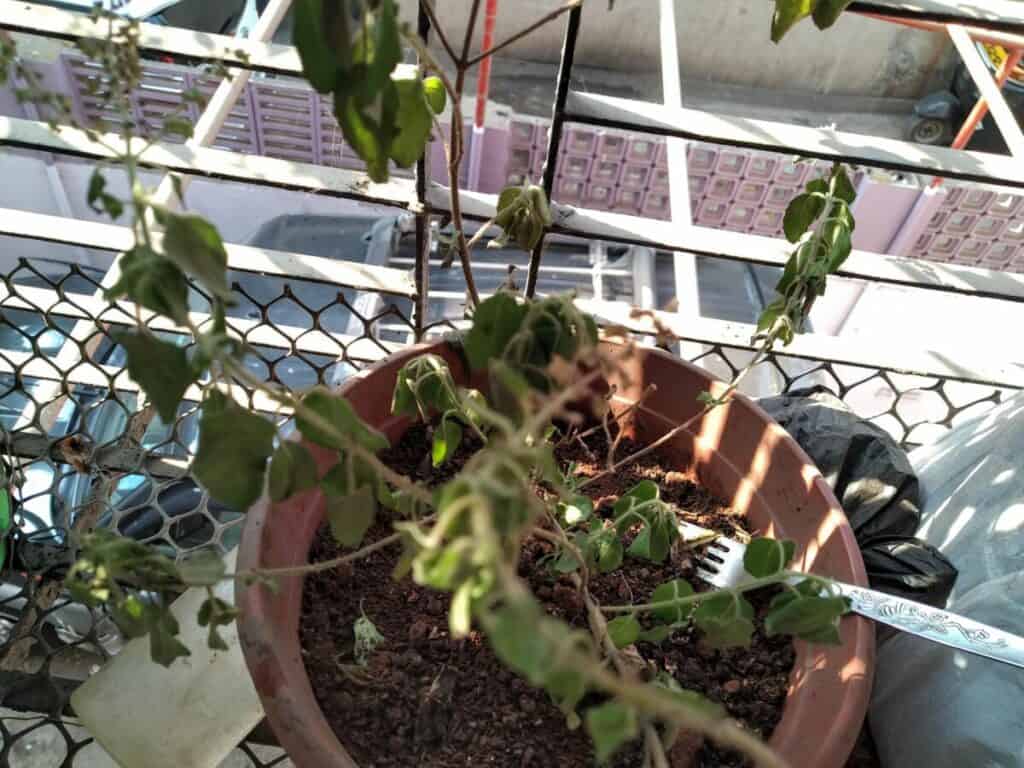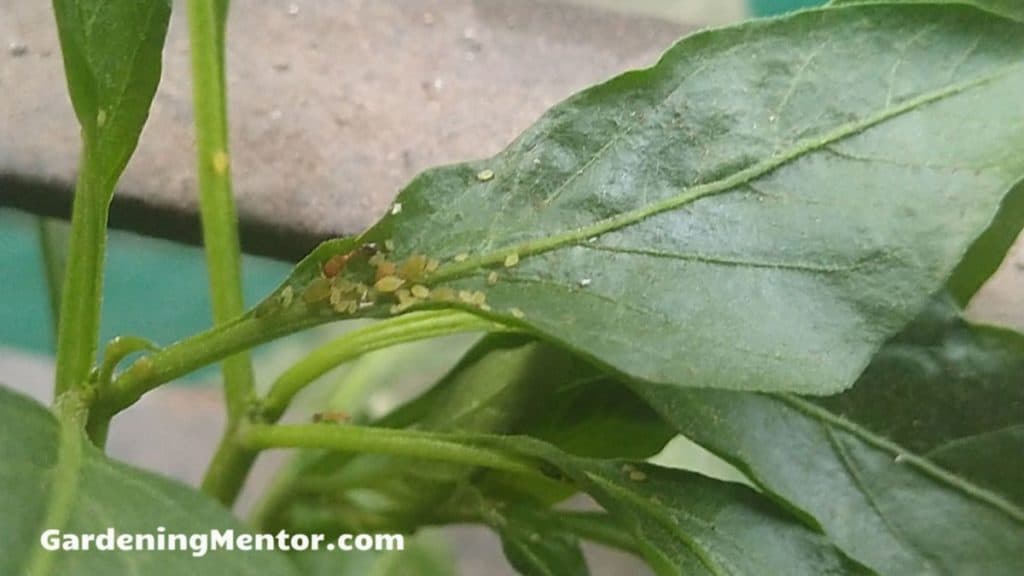It takes hard work to grow plants and it can be frustrating watching your seedling leaves turn brown. But you can figure the problem out and fix it.
Your seedling leaves are turning brown because of lack of water or overwatering conditions. The seedlings may be getting too much heat or cold. They may be having transplant shock or too much fertilizer causing browning. Pests and diseases may also cause browning.
As you can see there are several reasons the problem can happen. I’ve written down details about these and the solutions you can start using to bring back the health of your seedlings.
1. Overwatering or underwatering
The most common reason your seedling leaves turn brown is you are not giving them the right amount of water.
If you overwater the seedling, there is a chance that you are drowning the roots. This can happen if the soil has too much clay and the water is not draining well.
It can also happen if you are growing your seedlings in a container but there are not enough drainage holes at the bottom.
The roots are growing in the water which causes a fungal problem known as root rot. This turns them soggy, brown, and smelly. The roots can’t supply the seedling with the required nutrients and moisture.
The seedlings will show this by the leaves turning brown in color. They will be soft and droopy as well.
The leaves may turn brown if you don’t give enough water to the seedlings as well. The lack of moisture will show up in the leaves by them turning yellow or brown. The leaves will also be dry and brittle.

It’s simple to prevent the problem of overwatering or underwatering by ensuring the soil has good drainage properties.
Understand what plant you are growing and how much water it needs. Some plants are hardy and don’t need water as often while others may need plenty.
As a general rule, stick your finger 1-2 inches into the soil and check for moisture. Remove your finger and check if the soil sticks to it. If the finger is dry, only then should you water the soil.
If the roots have already suffered root rot, you’ll need to take out the plant and cut out the affected roots. If all the roots are having the problem, you’ll need to dispose of the seedling.
2. Too much sunlight
Another common reason the leaves of your seedling may turn brown is if they are getting more sunlight than required. The heat will cause the tip of the leaves to turn brown.
The leaves will also curl up as the plant tries to protect itself and retain the moisture it has. It wants to reduce the surface area that is exposed to the harsh sun.
This is not a serious problem but just an environmental condition. The leaves will return back to their healthy state when taken away from the sun.
You can help protect your plant by using a sun-block during the intense heat of the afternoon. If you’re growing the seedling in a container, you can move it in the shade when it gets too hot.
Make sure you don’t water the plant in the afternoon. The moisture on the leaves will heat up and scorch them which will damage the leaves.
3. Cold wind
The cold wind can have the same problem for the seedlings as intense heat. It will cause the moisture to dry out from the leaves causing them to turn brown.
This is an environmental problem as well that will cause the leaves to curl up and protect the moisture they can retain. Once the wind dies down, the leaves will return back to normal.
You can use a wind-screen that will protect the seedlings from such windy conditions. You can grow the seedling near a large plant or wall that can protect them from the wind. But make sure it does not block the required sunlight from them.
If you’re growing the seedling in a container, you can move it to a location that is protected from such wind.
4. Late freeze
There are some seedlings that will be hardier than others. This means they can cope with cold weather better than others.
You may be growing the seedlings when the temperature is right for them. But it can happen that the temperature drops in the night for a few days. There could be late freeze weather at night that will affect the seedlings.
This stress of the temperature change between day and night will cause the leaves of the seedling to turn brown. They will return back to normal when the weather again becomes suitable for them.
You can help out your seedlings by using a row cover during such nights with a late freeze. The row cover will keep them warm during the night.
Make sure to remove the row cover during the day so the seedling can get the required sunlight, aeration, and moisture.
5. Transplant shock
You may have started seeds indoors and grown the seedlings. Or you may have bought them from a nursery or garden center.
The seedlings have been grown indoors and if you try to directly plant them in your outdoor garden, they will suffer transplant shock. The stress will cause the leaves to turn brown.
Transplant shock happens because the seedling cannot cope with the harsh outdoor environment. The heat from the sun, dry wind, and moisture can stress out the seedling.
You need to get the plant used to these conditions before you can move it to the outdoor garden. The easiest way to do this is to keep the seedling out for a few hours every day and then bring it back indoors.
You need to keep the seedling away from harsh sunlight, wind, and moisture when you put it outside for a couple of hours. Keep doing this for a week and your seedling will be ready for the transplant.
Once you transplant the seedling outdoors, give it plenty of water that will help it cope with the transplant better.
6. Excess nitrogen
If you add too much fertilizer to the soil, the roots can burn up. This will affect the seedling leaves and turn them brown.
This is a more common problem when you’re using chemical fertilizer for your plants. If you’re not careful with the amount of fertilizer, the excess nitrogen will harm the roots.
I don’t recommend using chemical fertilizer for your seedlings. You can opt for an organic one that is slow-releasing and gentle on the plants.
You should follow the manufacturer’s instructions on the amount of fertilizer to use and how often you should apply it to the soil.
If the seedling is already suffering from nitrogen burn, the best you can do is keep watering the soil many times. This will help leach out the unwanted chemicals from the soil and improve the health of the roots.
7. Poor soil
Your seedling needs good soil to grow well. Good soil has the required texture so it retains sufficient moisture but drains out excess.
The soil should have good aeration so the roots can get the required oxygen. And the soil should have the required pH level as per the plant you’re growing.
If the soil has poor drainage, it leads to problems like overwatering that will drown the roots and cause the leaves to turn brown.
If the soil does not have the right pH level, the plant won’t get the required nutrients and the leaves will turn brown.
Make sure you have the right soil when growing the seedling. You can get a soil test done that will help you understand the quality of your garden soil.
You can get this soil test done by sending a few samples to a Local Extension Service in your area. The soil test will also provide you information on the amendments you can use to improve the soil.
8. Pests
Pests can be a problem in the garden that you may need to deal with at some point. Some of the pests will eat the leaves or suck the sap from them.
Pests like snails, slugs, caterpillars, and cutworms will eat the leaves and stress them out. Bugs like aphids and thrips suck the sap from the leaves causing brown spots.

The leaves won’t be able to produce the required nutrients due to the stress and start turning brown.
The precaution you can take is to keep your seedlings healthy so they can stay strong against pests. You can grow native plants that attract beneficial insects. They will feast on the pests and protect the seedlings.
The simplest solution to get rid of pests is to pick them by hand and dispose of them in a bucket of soapy water. You can get rid of snails, slugs, and cutworms using this method.
You can dislodge some pests like aphids and thrips using a spray of water on your leaves. They will fall into the soil and won’t be able to get back on the seedlings.
You can build a beer trap by using a small, deep tray that you place in a small hole near the plant. Fill this tray with beer that attracts these pests. They will fall into the container and drown.
Protect your seedlings from cutworms by wrapping the empty toilet paper tube around the base of the plant.
9. Diseases
There are some diseases that may infect your seedlings and cause the leaves to turn brown. This could be fungal diseases like root rot that reduces the nutrients reaching the leaves.
Or it could be something that impacts the leaves such as leaf spot. This disease starts developing brown spots on the leaves that increase in size.
The best prevention against fungal problems is to avoid humid conditions on the seedlings. When you water the plant, only water the soil and avoid splashing it on the foliage.
You should also keep sufficient distance between the seedlings so there is good air circulation between them.
There are also bacterial and viral diseases that can affect the seedlings and cause the leaves to turn brown. Some bacterial diseases are bacterial leaf spot and leaf blight. Some viral diseases are leaf curl and tomato wilt.
You can protect them by growing a disease-resistant variety.
Once a bacterial or viral disease infects the plant, it will slowly start to die and there’s not much you can do about it.

Fact Checked, Written, and Published by Kevin Rodrigues
Kevin is the founder of Gardening Mentor, a website that aims to teach people to grow their own food in a limited space. As a self-taught gardener, Kevin has spent several years growing plants and creating gardening content on the website. He is certified in Home Horticulture and Organic Gardening from Oregon State University. He has a Post Graduate Diploma in Horticulture and Landscape Gardening from Mumbai University.
Read more
